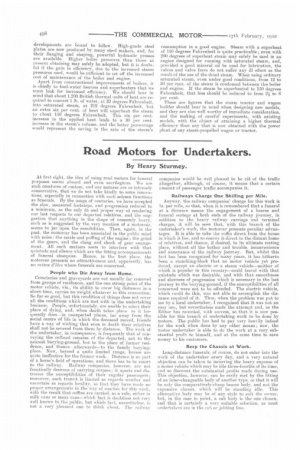Road Motors for Undertakers.
Page 4

If you've noticed an error in this article please click here to report it so we can fix it.
By Henry Sturmey.
At first sight, the idea of using road motors for funeral purposes seems absurd and even sacrilegious. We are such creatures of custom, and our natures are so intensely conservative, that we do not take kindly to some innovations, especially in connection with such solemn functions as funerals. By the usage of centuries, we have accepted the slow, measured footsteps, and progression reduced to a minimum, as the only fit and proper way of rendering our last respects to our departed relatives, and the suggestion that anything in the shape of unseemly hurry, suds as is suggested by the very mention of a. motorcar, seems to jar upon the sensibilities. Then, again, in the past, the motorcar has been associated in the public mind with noise: the rattle and puffing of the engine; the grind of the gears, and the clang and shook of gear engagement. All such matters seem to interfere with that quietude and silence which are the fitting accompaniments of funeral obsequies. Hence, in the first place, the motorcar presents no attractiveness and, apparently, has no raison d' etre where funerals nee concerned_
People who Die Away from Home.
Cemeteries and graveyards are not usually far removed from groups of residences, and the one strong point of the motor vehicle, viz., its ability to cover big distances in a short time, carries no weight whatever in this connection. So far so good, but this condition of things does not cover all the conditions which are met with in the undertaking business. People, unfortunately, are unable to select their place of dying, and, when death takes place as it frequently does—in unexpected places, far away from the social centre of life in ehich the deceased moved, friends have a way of wishing that. even in death their relatives shall not be severed from them by distance. The work of the undertaker, in consequence, is frequently that of conveying the coffined remains of the departed, not to the nearest burying-ground, but to the place of former residence, and thence-afterwards—to the family buryingplace. Now, beyond a quite limited range, horses are quite ineffective for the former work. Distance is no part of a horse's field of operations, and there has to be resort to the railway. :Railway companies, however, are not frantically desirous of carrying corpses ; it upsets and distresses the susceptibilities of their regular passengers; moreover, such transit is limited as regards number and uncertain as regards locality. so that they have made no proper arrangements in the 1N-ay of coaches for this work, with the result that coffins are carried, as a rule, either in milk vans or meat vans—which fact is doubtless not very well known to the public, but which fact. nevertheless. is riot a very pleasant. one to think about. The railway
companies would be well pleased to be rid of the traffic altogether, although, of course, it means that a certain amount of passenger traffic accompanies it.
Railways Charge One Shilling per Mile.
Anyway, the railway companies' charge for this work is is. per mile, so that, when it is remembered that a funeral at a distance means the engagement of a hearse and funeral cortege at both ends of the railway journey, in addition to the heavy railway carriage and terminal charges, it will be seen that, with this branch of the undertaker's work, the motorcar presents peculiar advantages. It is able to take the coffin direct from the house in which it lies, and to convey it direst to the distant home of relatives, and thence, if desired, to its ultimate resting place, without all the bother and trouble, inconvenience and annoyance of the railway journey. but, whilst this fact has been recognized for many years, it has hitherto been a stumbling-block that no motor vehicle yet producal, except. an electric or a steam vehicle—neither of which is popular in this country—could travel with that quietude which was deeirable, and with that smoothness and slowness of progression which is necessary in the last journey to the burying-ground, if the susceptibilities of all concerned were not to be offended. The electric vehicle, which could do this, was not able to accomplish the distance required of it. Thus, when the problem was put to me by a local undertaker, I recognized that it was not an easy one, but nevertheless made the attempt and, as the Editor has recorded, with success, so that it is now possible for this branch of undertaking work to be done by motors. The public has had to pay very heavily indeed for the work when done by any other means; now, the motor undertaker is able to do the work at a very substantial profit to himself, and at the same time to save money to his customers.
Keep the Chassis at Work.
Long-distance funerals, of course, do not enter into the work of the undertaker every day, and a very natural objection can be taken to incurring the heavy expense of a motor vehicle which may be idle three-fourths of its time, nail so discount the substantial prohts made during use. This objection, however, can be easily met by the fitting of an inter-changeable body of another type, so that it will be only the comparatively-cheap hearse -body, and not the expensive chassis, which will be standing idle. This alternative body may be of any style to suit the owner, but, in the case in point, a cab body is the one chosen, and that is certainly a very suitable selection, as most undertakers are in the cab or jobbing line.
























